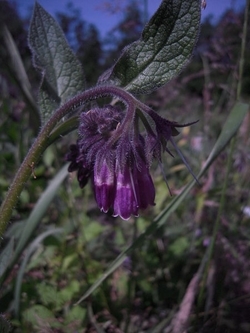Comfrey
 Comfrey (Symphytum officinale ) is a perennial herb of the family boraginaceae, to which other well-known plants belong such as borage and forget-me-not. Comfrey has a dark, almost black, turnip-like root that can drill a long way down into the sub-soil, sometimes up to an incredible 3 metres! The plant has large, wide hairy leaves and produces small bell-shaped flowers of various colours, typically of cream and purple, though these can vary quite widely. It is native to Europe and is usually found growing in damp places, such as along river banks and ditches.
Comfrey (Symphytum officinale ) is a perennial herb of the family boraginaceae, to which other well-known plants belong such as borage and forget-me-not. Comfrey has a dark, almost black, turnip-like root that can drill a long way down into the sub-soil, sometimes up to an incredible 3 metres! The plant has large, wide hairy leaves and produces small bell-shaped flowers of various colours, typically of cream and purple, though these can vary quite widely. It is native to Europe and is usually found growing in damp places, such as along river banks and ditches.
There are a number of different hybrid species also commonly found in the UK, the most frequent being known as Russian comfrey, which is generally more bristly and has flowers that tend to be more blue or violet in colour.
Many gardeners like to grow some comfrey as it is a particularly valuable source of fertility. Those searching roots can glean a good number of nutrients from the deeper soils, many of which would not normally be available to shallower-rooted plants. These are made available through its fast-growing big leaves that, lacking fibres, can be quickly broken down to produce a thick black liquid.
Comfrey is in particular an excellent source of potassium, which is of course an essential plant nutrient. Its leaves contain up to two or three times more potassium than an average farmyard manure. What is more, a mature comfrey plant can be harvested up to four or five times a year as it will rapidly regrow, and will be ready for further cutting about five weeks later. It is said that the best time to cut comfrey is shortly before flowering, for this is when it is at its most potent in terms of the nutrients that it offers.
Comfrey can continue growing into mid-autumn, but it is not advisable to continue taking cuttings after early autumn in order to allow the plants to build up winter reserves. Also, if you allow it to produce flowers, it will attract many bumble bees who absolutely love its thimble shaped flowers.
Comfrey leaves can be easily turned into liquid fertiliser, either by rotting the leaves down in rainwater for four-to-five weeks (thus producing a ready-to-use fertiliser) or by stacking dry leaves under a weight in a container with a hole in the base. When the leaves decompose, a thick black comfrey concentrate is collected which not only stinks, but is also quite strong, so should be diluted with water at about 15:1 before use.
Herbalists have long used comfrey. Its traditional name of knitbone coupled with the derivation of its Latin name symphytum – which comes from the Greek symphyo meaning “to unite” – tells you immediately that it was highly regarded because it stimulates cell division and can be remarkably effective in healing broken bones. The plant was also historically used to treat a wide variety of ailments ranging from bronchial problems, arthritis, burns and skin conditions.
Oh, and by the way, should you ever get stung by a stinging nettle, forget dock leaves if you happen to have comfrey to hand, as it is absolutely the best thing to rub on nettle stings. Pick a leaf, spit on it, rub it between your hands till it starts breaking up and then apply onto the affected area! The pain will disappear as if by magic!
Peter Thompson
Advisory
Read more from Peter Thompson at the Fresh from the Field blog.
Image © Jesse Taylor, used under the terms of the Creative Commons licence.

Download Peter Thompson's essential 26-page book, featuring beautiful photography and detailed profiles of Britain's wildlife
Download FREE >